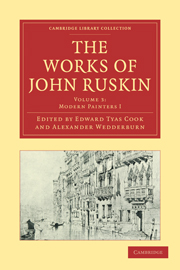Book contents
- Frontmatter
- Contents
- LIST OF ILLUSTRATIONS
- INTRODUCTION TO THIS VOLUME
- BIBLIOGRAPHICAL NOTE
- MODERN PAINTERS VOLUME I
- AUTHOR'S PREFACE TO FIRST EDITION (1843)
- AUTHOR'S PREFACE TO SECOND EDITION (1844)
- AUTHOR'S PREFACE TO THIRD EDITION (1846)
- AUTHOR'S PREFACE TO NEW EDITION (1873)
- AUTHOR'S SYNOPSIS OF CONTENTS
- PART I OF GENERAL PRINCIPLES
- SECTION I OF THE NATURE OF THE IDEAS CONVEYABLE BY ART
- SECTION II OF POWER
- PART II OF TRUTH
- SECTION I GENERAL PRINCIPLES RESPECTING IDEAS OF TRUTH
- CHAPTER I OF IDEAS OF TRUTH IN THEIR CONNECTION WITH THOSE OF BEAUTY AND RELATION
- CHAPTER II THAT THE TRUTH OF NATURE IS NOT TO BE DISCERNED BY THE UNEDUCATED SENSES
- CHAPTER III OF THE RELATIVE IMPORTANCE OF TRUTHS:—FIRST, THAT PARTICULAR TRUTHS ARE MORE IMPORTANT THAN GENERAL ONES
- CHAPTER IV OF THE RELATIVE IMPORTANCE OF TRUTHS:—SECONDLY, THAT RARE TRUTHS ARE MORE IMPORTANT THAN FREQUENT ONES
- CHAPTER V OF THE RELATIVE IMPORTANCE OF TRUTHS:—THIRDLY, THAT TRUTHS OF COLOUR ARE THE LEAST IMPORTANT OF ALL TRUTHS
- CHAPTER VI RECAPITULATION
- CHAPTER VII GENERAL APPLICATION OF THE FOREGOING PRINCIPLES
- SECTION II OF GENERAL TRUTHS
- SECTION III OF TRUTH OF SKIES
- SECTION IV OF TRUTH OF EARTH
- SECTION V OF TRUTH OF WATER
- SECTION VI OF TRUTH OF VEGETATION.—CONCLUSION
- Appendix
- Plate section
CHAPTER V - OF THE RELATIVE IMPORTANCE OF TRUTHS:—THIRDLY, THAT TRUTHS OF COLOUR ARE THE LEAST IMPORTANT OF ALL TRUTHS
Published online by Cambridge University Press: 07 September 2011
- Frontmatter
- Contents
- LIST OF ILLUSTRATIONS
- INTRODUCTION TO THIS VOLUME
- BIBLIOGRAPHICAL NOTE
- MODERN PAINTERS VOLUME I
- AUTHOR'S PREFACE TO FIRST EDITION (1843)
- AUTHOR'S PREFACE TO SECOND EDITION (1844)
- AUTHOR'S PREFACE TO THIRD EDITION (1846)
- AUTHOR'S PREFACE TO NEW EDITION (1873)
- AUTHOR'S SYNOPSIS OF CONTENTS
- PART I OF GENERAL PRINCIPLES
- SECTION I OF THE NATURE OF THE IDEAS CONVEYABLE BY ART
- SECTION II OF POWER
- PART II OF TRUTH
- SECTION I GENERAL PRINCIPLES RESPECTING IDEAS OF TRUTH
- CHAPTER I OF IDEAS OF TRUTH IN THEIR CONNECTION WITH THOSE OF BEAUTY AND RELATION
- CHAPTER II THAT THE TRUTH OF NATURE IS NOT TO BE DISCERNED BY THE UNEDUCATED SENSES
- CHAPTER III OF THE RELATIVE IMPORTANCE OF TRUTHS:—FIRST, THAT PARTICULAR TRUTHS ARE MORE IMPORTANT THAN GENERAL ONES
- CHAPTER IV OF THE RELATIVE IMPORTANCE OF TRUTHS:—SECONDLY, THAT RARE TRUTHS ARE MORE IMPORTANT THAN FREQUENT ONES
- CHAPTER V OF THE RELATIVE IMPORTANCE OF TRUTHS:—THIRDLY, THAT TRUTHS OF COLOUR ARE THE LEAST IMPORTANT OF ALL TRUTHS
- CHAPTER VI RECAPITULATION
- CHAPTER VII GENERAL APPLICATION OF THE FOREGOING PRINCIPLES
- SECTION II OF GENERAL TRUTHS
- SECTION III OF TRUTH OF SKIES
- SECTION IV OF TRUTH OF EARTH
- SECTION V OF TRUTH OF WATER
- SECTION VI OF TRUTH OF VEGETATION.—CONCLUSION
- Appendix
- Plate section
Summary
Difference between primary and secondary qualities in bodies.
In the last two chapters, we have pointed out general tests of the importance of all truths, which will be sufficient at once to distinguish certain classes of properties in bodies as more necessary to be told than others, because more characteristic, either of the particular thing to be represented, or of the principles of nature.
According to Locke, book ii. chap. 8, there are three sorts of qualities in bodies: first, the “bulk, figure, number, situation, and motion or rest of their solid parts: those” that “are in them, whether we perceive them or no.” These he calls primary qualities. Secondly, “the power that is in any body to operate after a peculiar manner on any of our senses” (sensible qualities). And thirdly, “the power that is in any body to make such a change in another body as that it shall operate on our senses differently from what it did before:” these last being “usually called powers.”
The first are fully characteristic; the second imperfectly so.
Hence he proceeds to prove that those which he calls primary qualities are indeed part of the essence of the body, and characteristic of it; but that the two other kinds of qualities which together he calls secondary, are neither of them more than powers of producing on other objects, or in us, certain effects and sensations.
- Type
- Chapter
- Information
- The Works of John Ruskin , pp. 158 - 162Publisher: Cambridge University PressPrint publication year: 2010First published in: 1903

